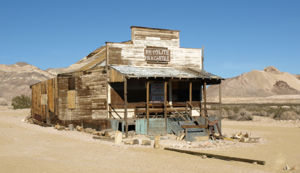Ghost Town
 From Conservapedia
From Conservapedia Ghost towns are often the site of old buildings and ruins, or in some cases the old buildings have been demolished. The designation of ghost town can include sites where a town was located and perhaps only a few foundations, or trace evidence remain.
These towns became ghost towns for different reasons. For some, the town fell into economic decline and all the residents eventually moved out. This is the case, for example, with towns which were former railroad crew change and watering points during the steam locomotive era. The diesel locomotive era made many of these towns, which existed only because of the need to service trains passing through, unnecessary. This can also be the case with former mining towns which experienced a boom, then a bust as the mine stopped being productive. Other ghost towns became uninhabited because they were evacuated because of a disaster.
Ghost towns are a common sight in the old American West. Nevada and Arizona in particular saw great periods of growth and decline in the Frontier period, and the remnants of that boom and bust cycle can be seen in its quiet villages and towns that were once thriving centers of commerce, trade and adventure. Ghost town can and do exist in every state in the U.S and Canada.
Examples of real ghost towns[edit]
- Bodie, California - considered to be the "classic" ghost town, located in Bodie State Park
- Cisco, Utah - a former railroad waystation on the Denver and Rio Grande Western Railroad
- Rhyolite, Nevada - a former mining town
- Chernobyl, Ukraine - due to nuclear disaster
- Centralia, Pennsylvania - due to 40 year mine fire
- Pripyat, Ukraine - due to nuclear disaster
Former ghost towns[edit]
The site of some former ghost towns has been converted to another purpose. An example is Times Beach, Missouri, which was evacuated in the early 1980s due to dioxin poisoning, but the site has since been cleaned up and converted into a state park.
Towns erroneously called ghost towns[edit]
Some towns like Tombstone, Arizona and Deadwood, South Dakota are erroneously referred to as ghost towns, when in fact they are actual inhabited towns which at one time saw a rapid decline after a mining boom, but never became actual ghost towns. Their "ghost town" status is a means of attracting tourists while in actuality they are tourist towns.
Centralia, Pennsylvania is often cited as a ghost town—but is still home to nine inhabitants. This town is often included in lists of ghost towns due to the more than 100 existing structures left in the town, making it semi-ghost. Many roads to the town are in disrepair and the state no longer recognizes Centralia as a town, village or hamlet.
Categories: [Sociology]
↧ Download as ZWI file | Last modified: 02/24/2023 16:08:01 | 9 views
☰ Source: https://www.conservapedia.com/Ghost_town | License: CC BY-SA 3.0
 ZWI signed:
ZWI signed:

 KSF
KSF